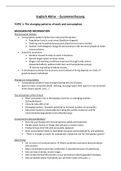Zusammenfassung
Englisch Zusammenfassung der Themen ABI 2021-22 , Baden-Württemberg
Englisch Abitur - Zusammenfassung aller Themen: TOPIC 1: The changing patterns of work and consumption Bsp:WOMEN IN WORKPLACE – TREND IS REVERSING • Four decades, number of women who started working grew fast, causing powerful cultural and economic transformation of America society. • Si...
[ Mehr anzeigen ]



